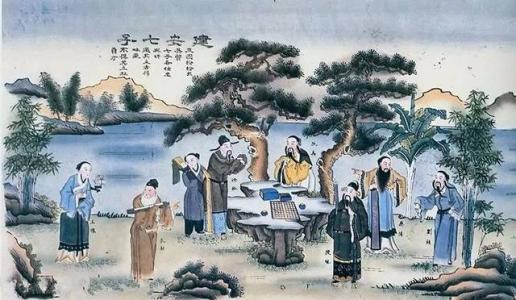Studies on ancient Chinese literary schools need theoretical thinking

Jian’an Qizi, an ancient literary school made up of seven literati during the Jian’an period (196–220) in the Han Dynasty, had an important position in Chinese literary history and made contributions to the development of poetry and prose.
Many literary schools deserve scholarly attention for being crucial to the study of ancient Chinese literature. Scholars should work to gain a full picture of these literary schools in the future, with extra focus on their theories and systematization.
Unique styles
Zhou Mingchu, a professor from the School of Humanities at Zhejiang University, cited from the Encyclopedia of China that aesthetic taste and writing style are among some of the elements shared by different literary schools.
More literary schools emerge as the studies on literary history continue to make progress. However, some schools resemble literary groups or literary clusters, which means it can be difficult for their recognition to gain currency in academia, Zhou said.
Literary schools fall into two categories. Some originated from ancient literary groups. In other cases, scholars named a literary school by identifying a group of writers who had common writing styles and were attracted by one or several representative writers. Generally, the elements of literary schools include systematization, style and representative writers, said Chen Wenxin, a professor from the College of Chinese Language and Literature at Wuhan University.
The rivalry among literary schools lies in style. Style is at the core when two literary schools of the same time period compete with each other or when a rising literary school throws down the gauntlet against its predecessor. A literary school can never exist without a unique style, Chen suggested.
Regional culture
Many literary schools were named after regions that have appeared throughout the history of ancient literature, especially in Jiangnan, the area south of the lower reaches of the Yangtze River.
Liu Chuan’e, a professor from Hubei University, held that regional culture has a fundamental impact on the literature within a region. Diverse local literature is a testament to China’s vast land and abundant resources. Thus, literary studies need to explore the relationship between writers and local culture.
Since the late Ming Dynasty (1368–1644), there have been many literary schools named after places. Hou said that these literary schools usually have distinct features. Activities were frequently conducted with poetic or literary themes. The schools were bolstered by renowned clans as many members were born in notable families. Members of literary schools were talented and proficient in various genres. Also, literary schools endured over a long time span.
Members of the literary schools that developed within a county tended to adopt similar content and style. The schools would exert greater influence when their representatives left the region to expand their horizons and social interaction, thus attracting people from afar to join the groups. Under such circumstances, these schools would evolve accordingly and stand out around the country, such as the Changzhou and Tongcheng Schools, Zhou said.
Chen suggested that scholars should keep in mind that the literary schools named after regions are the same as the ones named after renowned writers in particular respects. For example, the Jiangxi Poetic School gained its name because Jiangxi Province was the hometown of its leading poet Huang Tingjian.
Chen also noted that schools named after regions are different from those named after representative writers in other respects. A region’s cultural traditions might have been underlined as a result of the school’s naming, or the school’s naming might have been designed to emphasize a region’s cultural traditions. In terms of the literary schools named after regions, their members may have sought to enhance communication and align common pursuits, or this method of naming may have stressed the shared characteristics of writers from the same region.
Many case studies on literary schools have gained recognition. By contrast, academia should work harder to propose theories, Chen said. We should go beyond studies on writers, thus making progress in systematization and theory through a comprehensive examination of literary schools.
It is of great importance to strengthen the theoretical studies of ancient literary schools, Zhou said. The definition of literary schools should be clarified. And the boundaries differentiating literary schools, literary groups and literary clusters should be cleared.
(edited by MA YUHONG)
